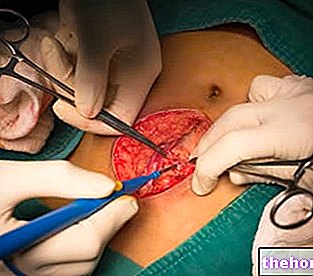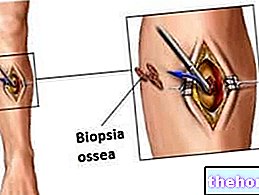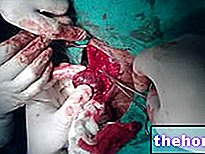Article by Dr. Antonio Darecchio
Generality
The hernia is the escape of a bowel or a part of it from the natural cavity that normally contains it; therefore there are hernias in various parts of the organism; abdominal or inguinal ones are undoubtedly the most frequent.
Aetiopathogenesis
Congenital hernias occur when a hernial sac is present from birth.

Even in hernias of an acquired nature there is often an anatomical predisposition combined with a weakness of the muscular tissues and above all aponeurotic (tendon - collagen) tissues.
On the basis of these assumptions, the fundamental actor in the appearance of the herniation is the endo-abdominal pressure which, acting on the areas of weakness, especially during exertion, tends to push the viscera out.
Pathological anatomy
The hernia, in its evolution, can give rise to a simple internal orifice or to a real canal consisting of an internal and an external orifice.
When the hernia travels through a real canal this can cross the abdominal wall according to an oblique or perpendicular path, therefore we speak of oblique hernias or direct hernias. the tip of the hernia (simple engagement of the inner ring), the "interstitial hernia (when the bowel stops in the thickness of the aponeurotic muscle wall) and complete hernia (when the external orifice is passed).
The hernial sac is made up of an ejection of the parietal peritoneum (a thin endothelial tissue that envelops the herniated viscera and engages in the various routes described above). There are 3 regions of the sac: the collar, the body and the bottom. The contents of the sac varies with the hernial area. The small intestine, the omentum and the colon constitute the most common hernial contents.
Symptomatology
In most cases, the patient complains of a gradual onset of swelling in a certain hernial area, but some hernias such as inguinal or epigastric hernias can be immediately painful and aggravated by the upright position associated with physical exertion.
Evolution
An untreated "hernia tends to increase and this increases the chances of complications.
There are untreated hernias that lead to the so-called "loss of home" of the abdominal organs, ie most of the abdominal viscera goes to occupy the hernial sac instead of the abdominal cavity with consequent problems on the thoracic compartment and respiratory dynamics.
Only surgical treatment can lead to healing of the hernia.
Complications
Hernial constriction is the most serious complication, being a constriction of the herniated bowel that can culminate in occlusion-gangrene-peritonitis.
Any exertion associated with a sudden increase in abdominal pressure can act as a determinant of hernial throttling.
Inguinal hernia
Inguinal hernia alone accounts for more than 90% of abdominal hernias; it frequently appears in the early years of life or at the end of adolescence (often congenital) to reach its peak in advanced age (often of the acquired type). female is rare, while crural hernia prevails.

The hernial sac can enlarge until it reaches the scrotum and in this case we speak of inguino-scrotal hernia.
Classical therapeutic solutions
They include all the operations performed through the open incision or inguinotomy. Two fundamental times of the intervention are identified: A) dissection and treatment of the sac B) Reconstruction of the inguinal canal.
The reconstruction that until the 1970s "took place mainly with the non-prosthetic method (Bassini-Posteski-Shouldice-Mcvay method) was burdened by a consistent risk of recurrence.With the introduction of prosthetic materials (mesh) and two main techniques called Liechtenstein and Trabucco, the recurrence rates have been significantly reduced. The prosthesis therefore fulfills the purpose of strengthening and integrating into the tissues, but at the same time constitutes a foreign body that must be fixed and housed in the tissues.
Of particular clinical interest are the conflicts between the implanted material and the nerve structures, which can give rise to complications of an acute and chronic painful nature.
Minimally invasive laparoscopic therapeutic solutions
The most used laparoscopic technique currently is TAPP (transabdominal preperitoneal); with this method you have the full videolaparoscopic vision of the abdominal wall from the inside, allowing the evaluation of both groins and / or associated abdominal pathologies.
Access occurs through the umbilical scar, thus limiting aesthetic damage. The prosthesis is inserted and placed on the abdominal wall from the inside, avoiding bloody dissections and is housed in a space called the pre-peritoneal space; this very thin space is itself devoid of vascular and nerve structures. The prosthesis can be fixed with various additional techniques and devices. The staples or spirals called tacks can however give rise to lesions of a vascular-nervous nature.
The tissue adhesives, on the other hand, which are real biocompatible glues, allow the fixing of the prostheses in a traumatic way, greatly reducing the risk of complications.
Bibliography: http://www.ncbi.nlm.nih.gov/m/pubmed/22015810/
Crural Hernia
It is a less frequent type of hernia than the inguinal one, which appears more often in women after 30 years of age. The crural ring, which is the site of weakness of this hernia, corresponds to an anatomical space immediately below the inguinal ligament and in close relationship with the femoral vessels (artery and vein).

Therapy
In analogy with inguinal hernias, there are classic techniques that include open incision and simple plastic (Bassini technique) or prosthetic (Rutkow technique), or mini-invasive laparoscopic video techniques.
Umbilical Hernia - Epigastric Hernias - Laparoceli
All of these hernias involve the anterior abdominal wall. The umbilical hernia of the adult is found in order of frequency in the third place after the inguinal and the crural; its frequency is increased in the obese.
The dimensions are very variable, from the small hernial sac to the giant hernias with loss of home of the viscera. Epigastric hernia is always a midline defect of the anterior abdominal wall that is higher than the navel. Even for this type of hernia, the most fearful complication is strangulation. Laparoceli refers to hernias arising from previous surgical interventions.

Umbilical hernia
Therapy
The therapeutic principles do not differ from those described so far and provide for classic or mini-invasive laparoscopic techniques.
Classic techniques
It is necessary to perform an open incision to isolate the hernial sac and reduce it in the abdomen; at this point the reconstruction of the abdominal wall can take place directly (without prosthesis) or prosthetic with the use of "Mesh" to strengthen the tissues surrounding.
Therapeutic Solutions
Laparoscopic Techniques for the Treatment of Abdominal Hernias
Through some millimetric lateral accesses to the abdominal cavity (usually three) it is possible to see the wall defect from the inside by videoscopy and to introduce a particular type of Mesh called intraperitoneal.
After reducing the hernial content, it is possible to apply the prosthesis by fixing it to the abdominal wall with traumatic mechanical means such as points, metal spirals or anchors called Tacks.

Application of a Mesh in Laparoscopy. This operation aims to prevent a new herniation (recurrence) through the weak point of the abdominal wall.
The classic metallic materials used for fixing this "artificial mesh" can give rise to complications. For this reason, when circumstances permit, it is preferable to use biological fixing adhesives. Image taken from the site: californiaherniaspecialists.com
Unfortunately, these means of prosthetic fixation can give rise to complications of a haemorrhagic or algic nature (acute and chronic pain). Alternatively, with the innovative technique developed by Dr. Darecchio and his team, the prosthesis can be fixed in a non-traumatic way thanks to the use of tissue adhesives and a particular applicator specifically dedicated to this type of intervention.
Darecchio technique
Mini-Invasive Technique for the Treatment of Abdominal Hernias
Being less traumatic, tissue adhesives allow the prosthesis to be fixed without causing vascular and / or nerve damage and can reduce the complication rate in this type of surgery.
This is the innovation introduced by the Italian surgeon Dr. Antonio Darecchio, who has developed a laparoscopic technique that allows to treat the hernial pathology of the abdominal wall, in a less invasive way thanks to the "use of special" biological glues "to fixing the prostheses, instead of staples or traumatic, which can cause severe pain or complications.
The technique is based on the use of a single-use and low-cost surgical instrument. This instrument traps the CO2 gas normally used in laparoscopy inside a thin and transparent plastic balloon. The low pressure inflatable chamber that is created occupies the entire abdominal cavity. At this point the balloon assumes the shape of the abdominal cavity within which it swells and in this way makes the prosthesis adhere to the parietal peritoneum in a total and perfect way. The prosthesis can be securely fixed to the abdominal wall using surgical adhesives.

Despite the medical advances of the last decade, explains the surgeon, the postoperative complications with the techniques currently most used can be many: the extensive incision of traditional surgery is very invasive, the tacks, metal spirals and sutures used for fixing the prosthetic retina are foreign bodies that our body can refuse in the long run, the pain can become chronic and the convalescence is very long.
With this technique, through a 12 mm incision it is possible to treat the hernia in a less traumatic way, giving the patient a possibility of quick recovery and less risk of complications. Furthermore, the prosthesis positioned intraperitoneally has a high resistance to physical loads and for these reasons it is particularly suitable for patients who practice fitness and body building at a professional level.
For further information, please refer to Dr. Antonio Darecchio's website: www.internationalherniacare.com.




.jpg)























